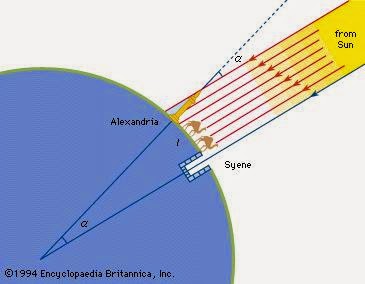This
library contained almost a million books in the form of scrolls, lecture rooms,
and meeting halls and would be classified today as a university. Eratosthenes
is said to have committed suicide by voluntary starvation in 255 B.C.E. Though
little remains of his original work, Eratosthenes is credited with two major
discoveries: the measurement of the size of the Earth and his sieve for finding
prime numbers.
Prime numbers are numbers that can
only be divisible wholly by itself and by 1. Eratosthenes’ sieve is still used
today in mathematical research to find prime numbers. He discovered that if all
natural numbers were written down from 2 to infinity and every other number
after 2 was removed, then the multiples of 3 were then removed, and it was
continued with the next available number and so on, it would leave a list of prime
numbers. This could then be used to find primes for any limit needed.
 |
During the longest day of the year,
Eratosthenes noticed there were no shadows upon the walls of Syene, a city just
south of Alexandria, due to the Sun being directly above the city at this time
of day. Since he noticed that there were shadows in Alexandria, which was just
north of Syene, he figured that there was a correlation with the angle of the
shadows and the circumference of the Earth. He did this under the assumption
that the Sun was so far away that its rays were parallel and that the Earth was
a sphere. Eratosthenes then used his knowledge of the angles of the
rays/shadows falling on Alexandria and Syene along with the distance between
the two cities to calculate the circumference of the Earth.
Eratosthenes calculated the Earth’s
circumference as approximately 250,000 stadia, which is converted to
approximately 25,000 miles (~40,233.6 km). Currently, the circumference of the
Earth is known as 40,075 km meaning that his approximation back then is within
1% accuracy to the actual value of the circumference of the Earth. His findings
were a huge advance in a time where the Earth was not perceived as a spherical
object.





*no references, in-text citations, figure references; this is considered plagiarism *
ReplyDelete